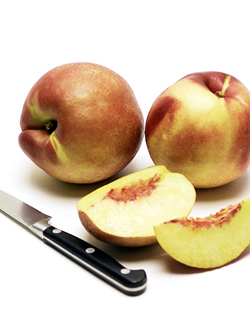TIP OF THE DAY: Summer Fruits & Vegetables, Part 2
|
Yesterday, chef Johnny Gnall highlighted new ways to serve seasonal produce. Today he discusses five more fruits and vegetables, bursting with flavor and waiting for you to pick up a pound or two. If you have questions or suggestions for tips, email Chef Johnny.
OKRA Some people can get weird about okra, and with good reason. If cooked improperly (which, it appears, is quite often), it can get slimy. No one over the age of five wants to eat slime, so okra tends to get avoided or neglected. This is a shame, as it good okra is…very good, and also quite nutritious. My favorite way to eat okra is to pickle it. Simply combine equal parts vinegar (any kind works but I like champagne vinegar or apple cider vinegar), water and sugar, in enough quantity to cover the okra in a deep pot. |
 Pickled okra. Photo courtesy ArtisanalCheese.com. |
|
|
Big, juicy peppers are at their sweetest and most flavorful at summer’s peak. The simplest, most delicious way to prepare peppers is to grill them, which couldn’t be easier during barbecue season. |
||
 Stone fruits are in their glory: raw, grilled or puréed into vinaigrettes. Nectarine photo courtesy Melissas.com. |
SUMMER SQUASH
Tender and prepared simply, summer squash—yellow squash and zucchini—is indubitably one of my favorite summer produce items. Its versatility is a big part of its appeal: You can roast it, sauté it, blanch it, braise it stew it, grill it, broil it, sear it…and of course, enjoy it raw in salads, as crudités or a garnish—matchsticks atop a chop or filet, for example. Summer squash is well complemented by virtually every herb, spice, sauce and starch in the fridge or pantry. There is very little it won’t pair with, from richer proteins like lamb and steak to more delicate ones like poultry and fish. I find that the easiest way to match summer squash to a protein is in how thick you cut it. |
|
|
Serve it up spicy, sweet, or savory; summer squash stands up and delivers, and it couldn’t be simpler. TOMATOES If you shop farmers markets in the summertime, you’ve probably tasted some pretty insane tomatoes. They’re one of those foods that tend to literally burst in your mouth with flavor and texture when you bite into them. Their flavors can range from sugary sweet to puckeringly tart, or hit any note in between. When they’re at their best, and you’re lucky enough to find some well cared for heirloom varietals, the dazzling colors and patterns on the surface of their skin can be mesmerizing. But we’ve all had captivating caprese salads and bodacious BLTs; we know what the tomato can do… right? Well don’t get tomato jaded just yet. For your next summer cocktail party, how about serving up some homemade heirloom tomato Bloody Mary martinis? I have saved the best for last. There is absolutely nothing quite like a perfectly ripe and ridiculously juicy stone fruit, be it apricot, cherry, nectarine, peach, plum, plumcot or pluot. Sometimes I feel that I could eat them without stopping: I imagine a never-ending bushel of rosy peaches sitting in a sunny field of clover, reaching in for another and another, taking no heed of the nectar spilling down my cheeks. It’s pure bliss on your taste buds, and it only comes around for a few months a year.
|
||


